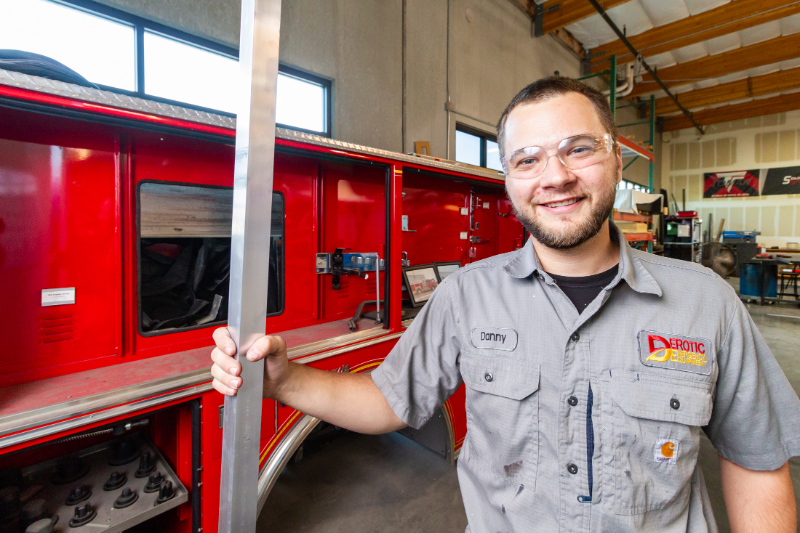Integration of Specialized Equipment in Emergency Vehicles

When it comes to emergency situations on the road, having the right tools and equipment readily available is everything. Emergency vehicles, including fire trucks, ambulances, and rescue vehicles, are equipped with specialized gear for a wide range of emergencies.
If you require emergency vehicle repairs or services, please contact Derotic Emergency Equipment today.
Purpose and Importance of Specialized Equipment
Enhancing Emergency Response Capabilities
Specialized equipment in emergency vehicles enhances the capabilities of emergency responders. Whether it's providing medical assistance to accident victims, extinguishing fires, or rescuing individuals trapped in hazardous situations, this equipment enables responders to act swiftly and decisively. According to statistics from the National Fire Protection Association (NFPA), specialized equipment significantly reduces response times and improves overall outcomes in emergency situations.
Examples of Specialized Equipment
- Medical Equipment: Ambulances are equipped with advanced medical devices such as defibrillators, ventilators, and cardiac monitors to provide immediate care to patients.
- Firefighting Gear: Fire trucks carry hoses, pumps, and extinguishers to combat fires effectively and protect lives and property.
- Extrication Tools: Hydraulic rescue tools, commonly known as the "Jaws of Life," are used to extricate individuals trapped in vehicle accidents.
- Hazardous Material Response Equipment: Specialized vehicles are equipped with protective gear and decontamination units to handle hazardous material spills safely.
Types of Specialized Equipment
Medical Equipment
In the medical category, emergency vehicles are equipped with a wide array of equipment to stabilize patients and provide essential care en route to medical facilities. This includes:
- Automated External Defibrillators (AEDs) for treating cardiac arrest.
- Portable oxygen tanks for patients experiencing respiratory distress.
- Intravenous (IV) supplies for administering medications and fluids.
Firefighting Gear
Fire trucks are outfitted with specialized firefighting equipment to extinguish fires efficiently. Key pieces of firefighting gear include:
- High-pressure hoses capable of delivering large volumes of water or fire-retardant foam.
- Fire extinguishers of various types, such as water, foam, or dry chemical, to tackle different types of fires.
- Thermal imaging cameras to locate hot spots and trapped individuals in smoke-filled environments.
Extrication Tools
Extrication tools are essential for rescuing individuals trapped in vehicles following accidents. Common extrication tools include:
- Hydraulic spreaders and cutters to remove debris and free trapped occupants.
- Ram bars for creating space and providing access to victims.
- Stabilization equipment to prevent further injury during extrication operations.
Hazardous Material Response Equipment
Specialized vehicles equipped to handle hazardous material incidents are equipped with:
- Personal protective equipment (PPE) such as chemical-resistant suits, gloves, and respirators.
- Decontamination units for cleansing individuals and equipment exposed to hazardous substances.
- Monitoring devices to detect and assess the extent of chemical or biological contamination.
Challenges and Considerations
Space Constraints and Weight Limitations
One of the primary challenges in integrating specialized equipment into emergency vehicles is the limited space available. Emergency vehicles must accommodate a wide range of equipment while ensuring adequate space for personnel and patient transport. Additionally, weight limitations pose constraints on the amount of equipment that can be safely carried, especially in smaller vehicles such as ambulances.
Compatibility Issues
Ensuring compatibility between different pieces of equipment is crucial for seamless operation during emergencies. Compatibility issues may arise when integrating equipment from different manufacturers or when upgrading existing systems with newer technologies. Proper testing and validation are necessary to ensure interoperability and reliability in the field.
Training and Maintenance
Effective utilization of specialized equipment requires training for emergency personnel. Training programs should cover equipment operation, maintenance procedures, and emergency response protocols. Regular maintenance and inspection of equipment are essential to ensure optimal performance and reliability during emergencies. Neglecting maintenance can lead to equipment failures and compromise emergency response efforts.
Accessibility and Cost-effectiveness
Accessibility of specialized equipment during emergencies is critical for rapid deployment and effective utilization. Equipment should be securely stored and easily accessible to responders when needed. Moreover, cost-effectiveness is a key consideration for agencies procuring specialized equipment, balancing the need for cutting-edge technology with budgetary constraints.
Future Trends and Innovations
Advancements in Robotics and Artificial Intelligence
The integration of robotics and artificial intelligence (AI) holds promising potential for enhancing emergency response capabilities. Robotic systems capable of autonomous firefighting, search and rescue, and hazardous material handling are being developed to augment human responders. AI algorithms are being used to analyze vast amounts of data from sensors and cameras installed on emergency vehicles, providing real-time insights and predictive analytics to responders.
Materials Science Innovations
Advancements in materials science are driving innovations in lightweight and durable equipment for emergency vehicles. Carbon fiber composites, for example, offer superior strength-to-weight ratios compared to traditional materials, enabling the design of stronger yet lighter equipment. Nanotechnology-based materials are also being explored for their potential to enhance the performance and longevity of emergency gear.
Integration of IoT and Connectivity
The Internet of Things (IoT) and connectivity technologies are revolutionizing the way emergency vehicles operate and communicate. Smart sensors and connected devices embedded in equipment and vehicles enable real-time monitoring of vital signs, equipment status, and environmental conditions. Seamless connectivity between emergency vehicles, command centers, and medical facilities facilitates rapid coordination and decision-making during emergencies.
Looking Ahead
The integration of specialized equipment in emergency vehicles is essential. From medical devices and firefighting gear to extrication tools and hazardous material response equipment, each piece of specialized equipment plays a vital role in mitigating emergencies. By staying up-to-date with emerging trends and adopting innovative solutions, professionals in the commercial trucking industry can ensure they are equipped to handle emergencies safely and efficiently on the road.
Contact Us
We're your one-stop shop for emergency and commercial vehicle repair and maintenance services in Rancho Cordova, Sacramento & San Bernardino, California. Get in touch with us today to schedule repairs or inquire about sales.

